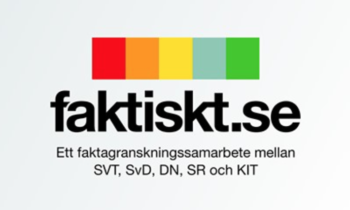 A new Swedish fact-checking outlet is copying another project in Norway. They even have the same name.
A new Swedish fact-checking outlet is copying another project in Norway. They even have the same name.
“Basically we’ve chosen the same name in Swedish, but with a T — Faktiskt,” said Martin Jönsson, editorial development manager at the daily newspaper Dagens Nyheter (DN). The name translates to “in fact.”
Based on Faktisk, a Norwegian fact-checking site launched over the summer, Faktiskt launched on Wednesday in partnership with five major Swedish media outlets. They include: DN, Sveriges Radio, Sveriges Television, Svenska Dagbladet and KIT.se.
That model, in which fact checks are published on each partner site, was pioneered by Faktisk — amassing it more than 1 million pageviews and hundreds of thousands of unique visitors over about three months. For Faktiskt, the goal is the same: Give fact checks the widest distribution possible.
“We have different audiences,” Jönsson said. “Together, the four of us are those of the largest media companies in Sweden, so we will have a huge audience.”
And so far, it’s been pretty successful. Jönsson told Poynter that they racked up 5,000 new social media followers and 30,000 pageviews to the Faktiskt site within its first day — most of which came through partner organizations’ sites. At DN, one fact check was the second most-read article all day.
“The reception has been very positive, with the expected exceptions from those getting red flags,” he said.
The idea for Faktiskt was born at SXSW in 2017. Jönsson told Poynter he had the idea for starting a fact-checking project in Sweden after listening to First Draft’s Claire Wardle and the Duke Reporters’ Lab’s Bill Adair speak. (Disclosure: The Reporters’ Lab helps pay for the Global Fact-Checking Summit.)
Misinformation has been a growing problem in Sweden. And Jönsson said there’s a palpable need for more factual political coverage — especially five months ahead of the Sept. 9 election.
“We have already seen a lot of fact resistance being very dominant in the political debate climate. Opinions matter — facts don’t,” he said. “There’s been a lot of virality when it comes to the spreading of fake stories or tweeted, misrepresented stories.”
While Faktiskt borrows mostly from its Norwegian cousin, there are some notable differences. Instead of uniting journalists from all five publications under one newsroom, they’ll contribute fact checks separately. Like Faktisk, they’re publishing articles on both Faktiskt.se and each individual organization’s website, as well as promoting them on branded social mediaaccounts.
But there’s still a bigger focus on individual work — and no journalists are dedicated solely to the fact-checking project. Jönsson said he’s encouraging any data and political journalists to get involved and contribute.
“We saw that there are some advantages to (Faktisk’s) ways of working, but some disadvantages as well in terms of keeping the publishers’ freedom of responsibility,” Jönsson said. “We also want to be able to compete with each other when it comes to fact-checking stories.”
Poynter reached out to Faktisk but had not received comment as of publication.
As for methodology, Faktiskt’s rating system is pretty standard: Completely true, partly true, misleading, partly false or completely false. In addition to support from each partner organization, the project is funded by a maximum of $200,000 from a government research institute, Vinnova, which Jönsson said mostly went toward developing the website.
To him, Faktiskt’s distribution strategy is the biggest benefit — and it’s a familiar one, even outside of the Nordic countries.
In an email to Poynter, Mark Stencel, co-director of the Reporters’ Lab, pointed to projects like Faktenfinder in Germany, SNU FactCheck in South Korea and PolitiFact’s media affiliates around the United States as examples of fact-checkers broadening their reach through media partnerships. (Disclosure: Poynter owns PolitiFact.)
To him, the model offers two key benefits: Scalability and credibility.
“What these and other collaborative projects show is that there is an economy of scale when media companies work together on fact-checking, either on the reporting side or the distribution side,” he said. “There also might be an economy of credibility. These fact-checking partnerships put the credibility of several different media brands behind this kind of journalism, using their combined weight to push back on untruths and misinformation.”
In the future, Jönsson said there could be room for including more media organizations in the project. In February, he’d already been contacted by about four or five who were interested.
After the election is over, Jönsson said the project will be a failure if it fails to reach the people who need fact-checking most.
“Our greatest mistake would be to say we didn’t know what was going on in this election, like some American media companies said after November (2016),” he said. “What we want to do is sort of place fundamental fact-checking under the political debate in the last six months of the election.”
“Our task is to show things the way they are.”
